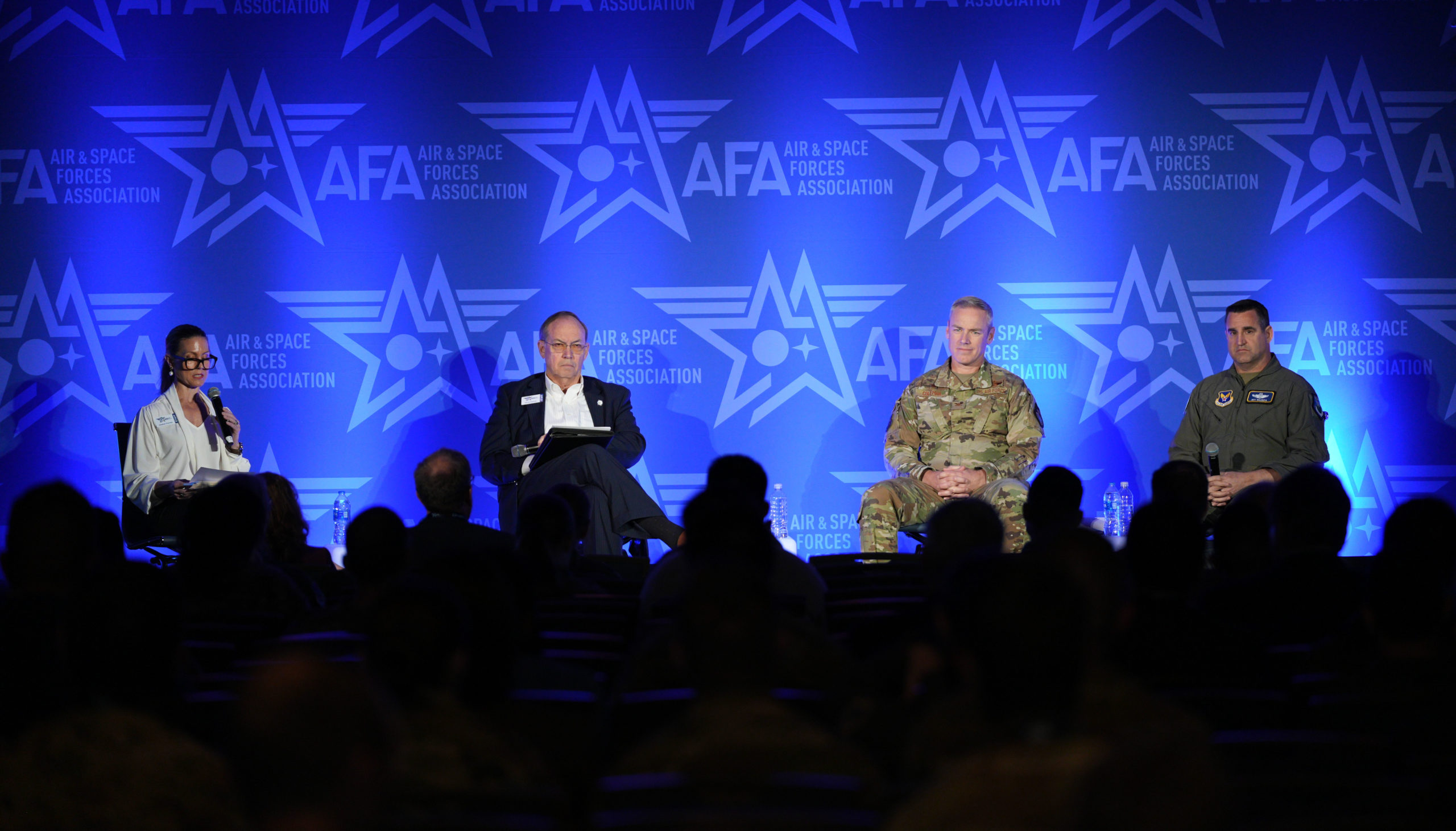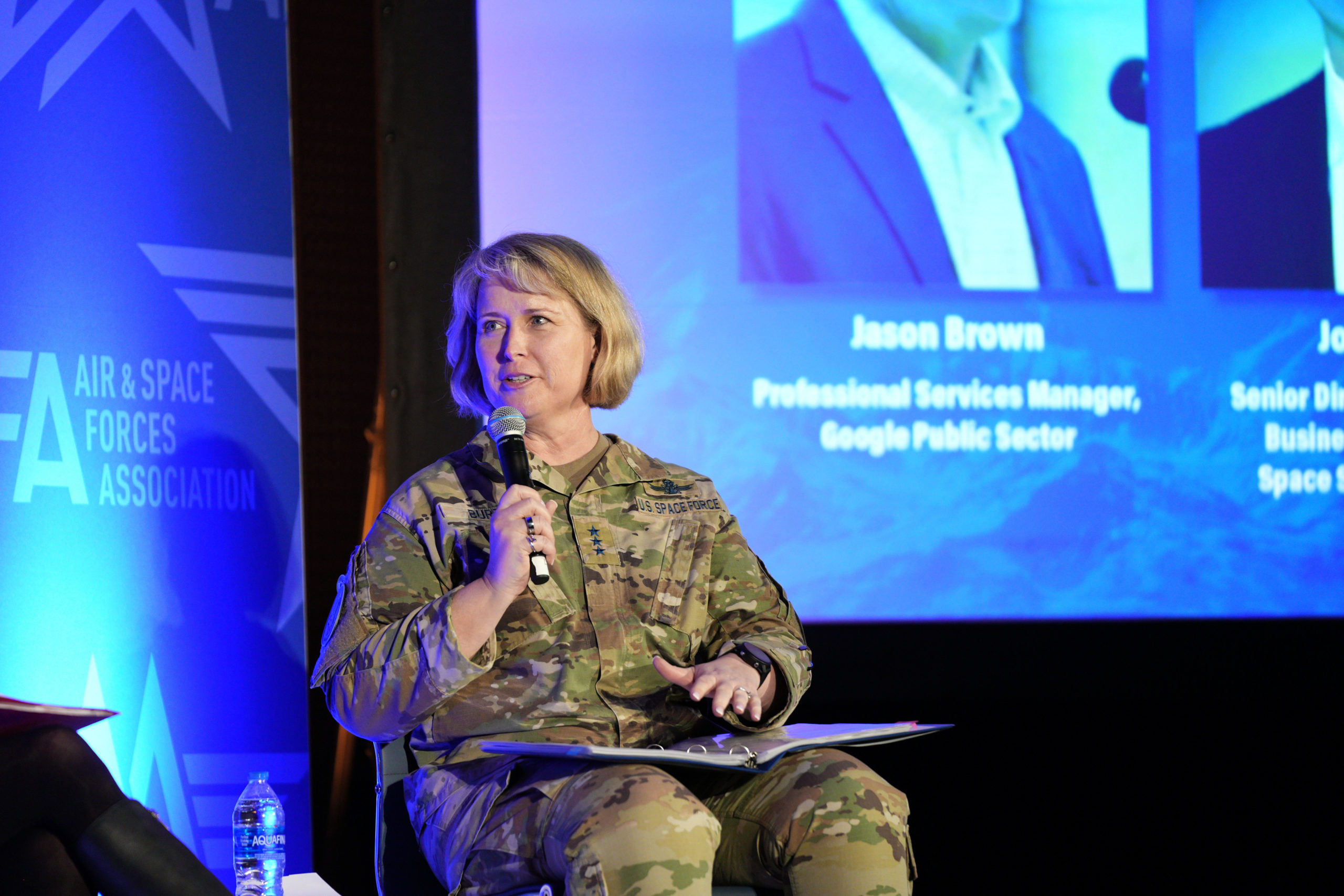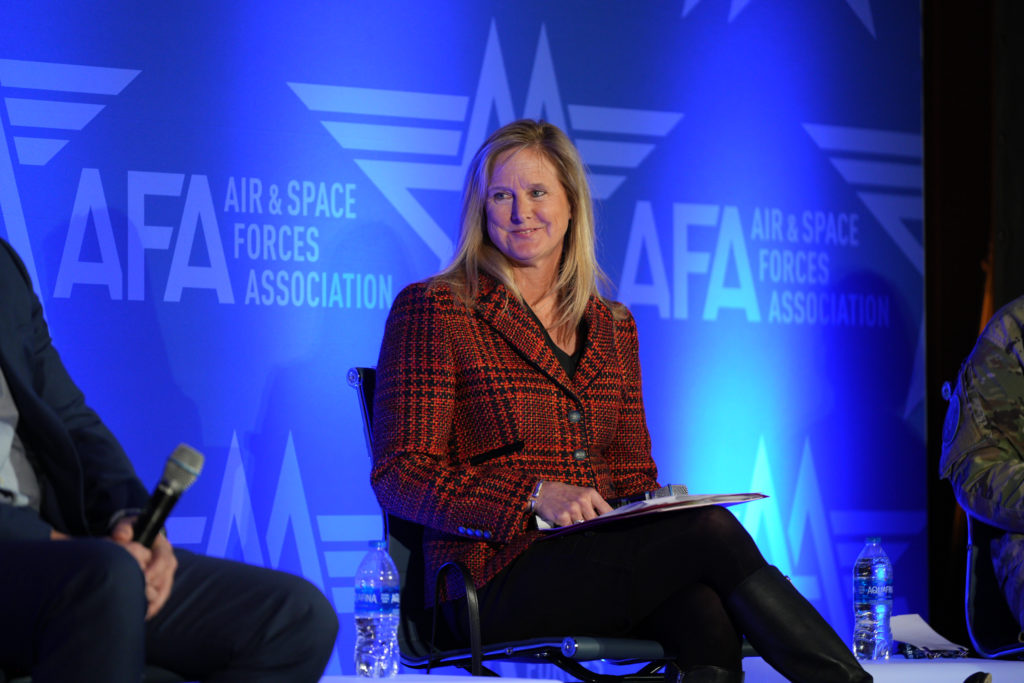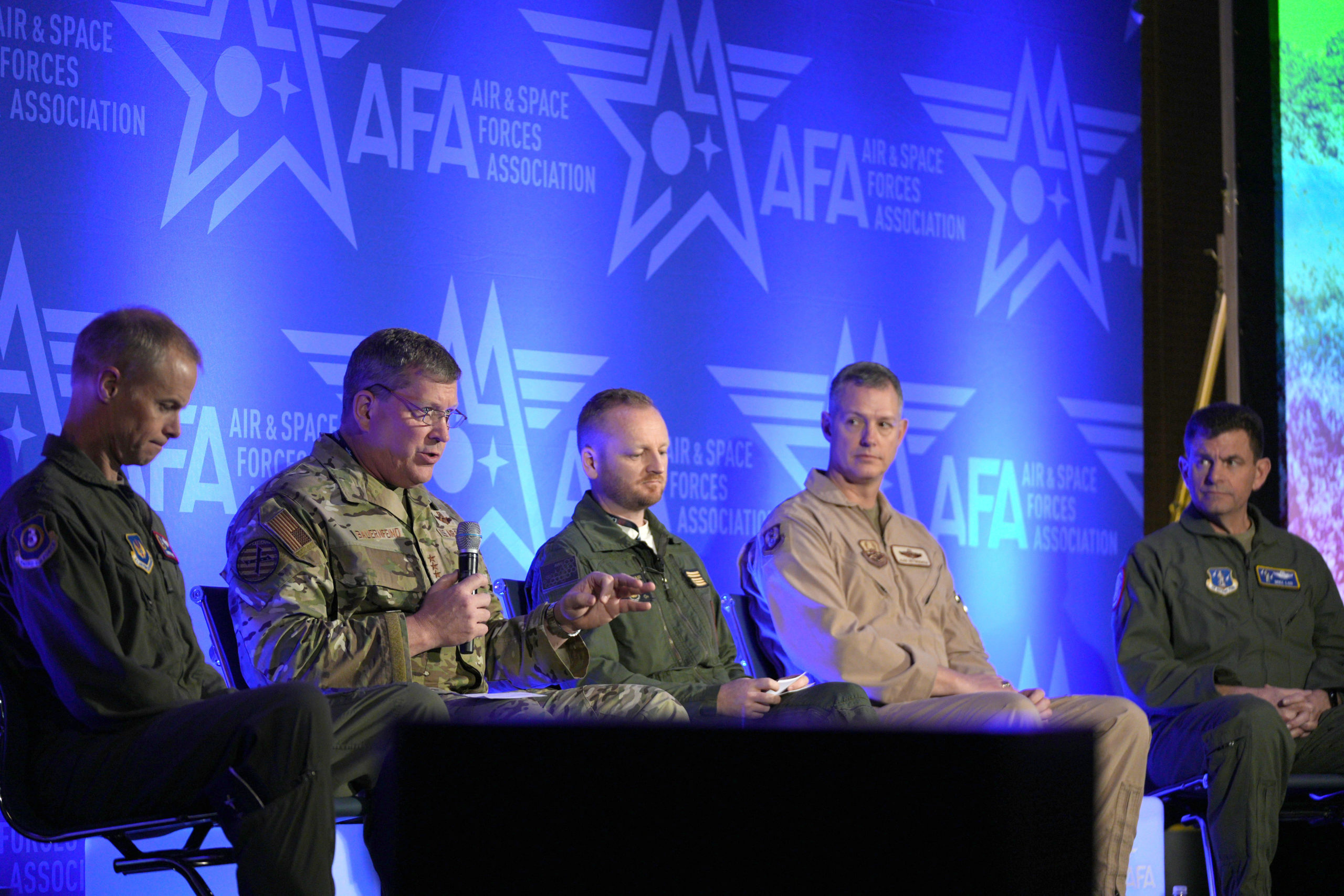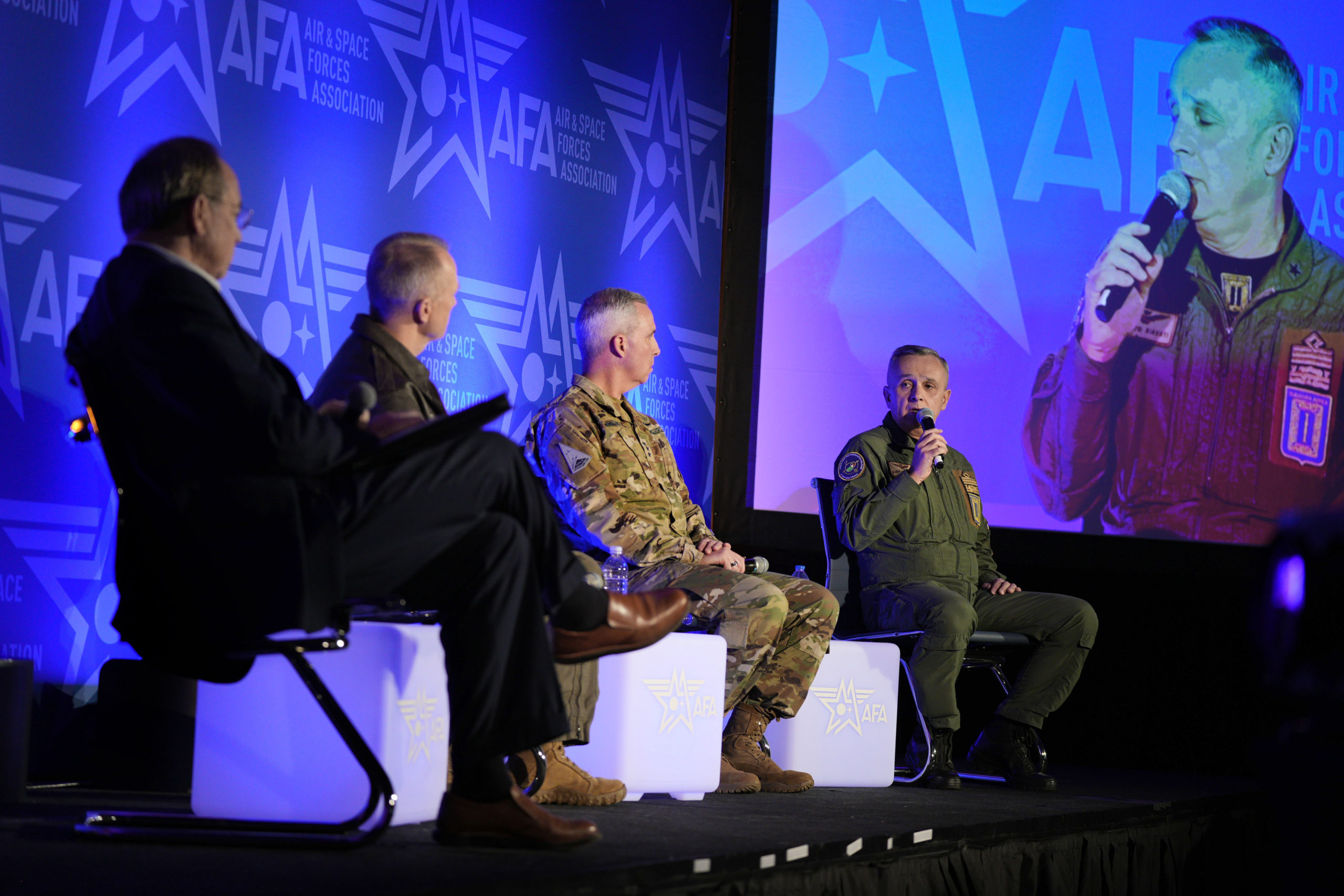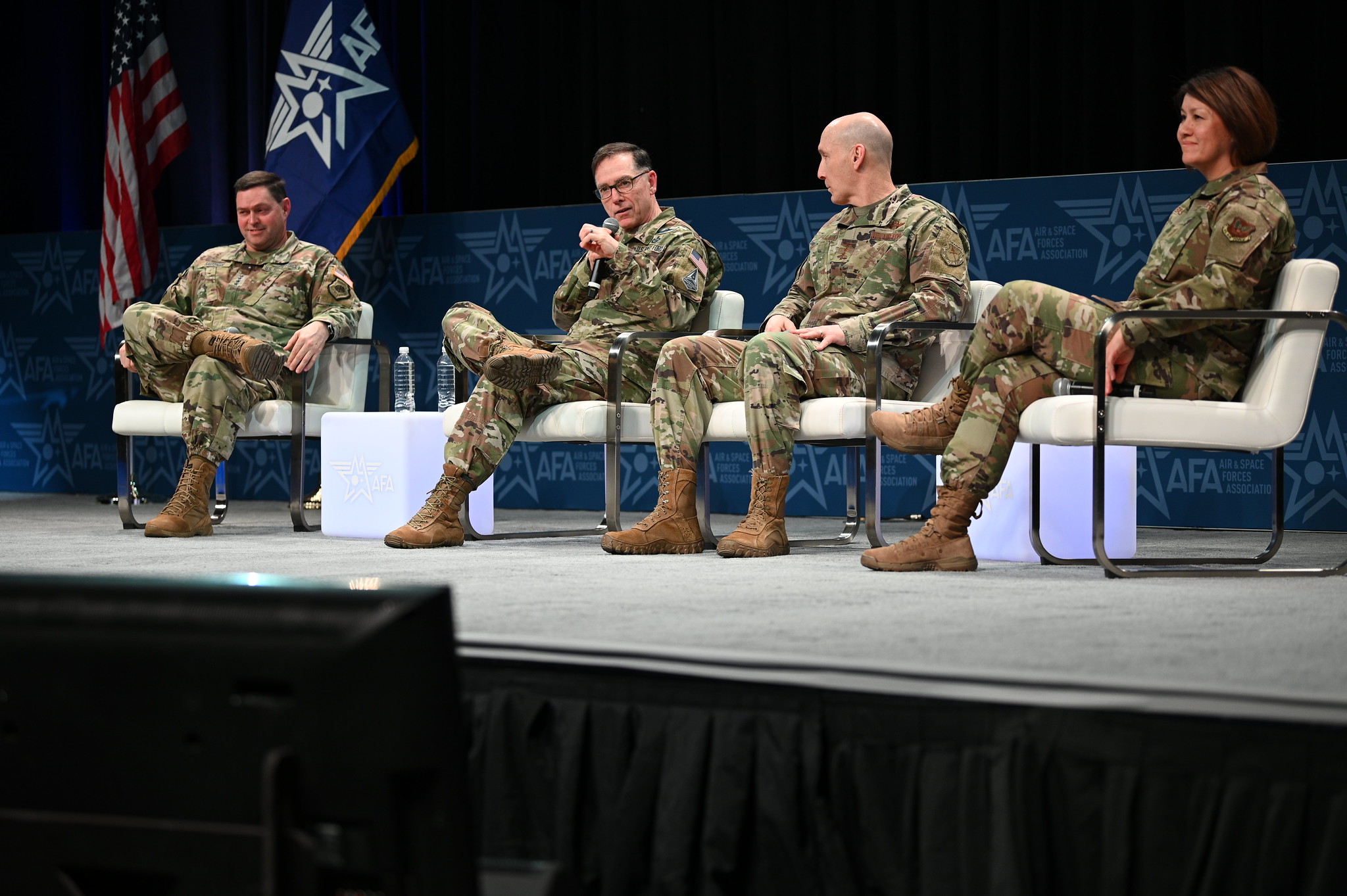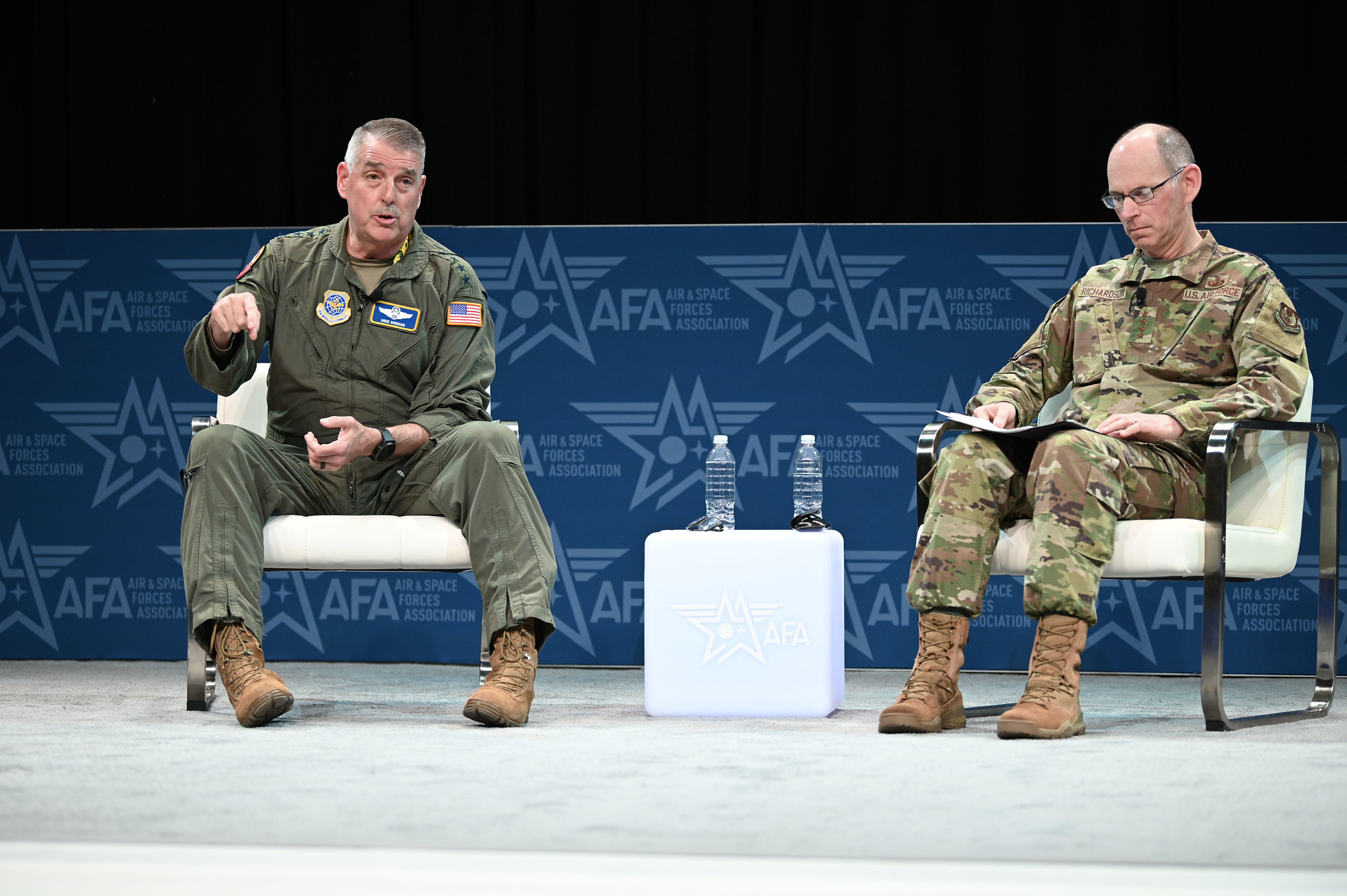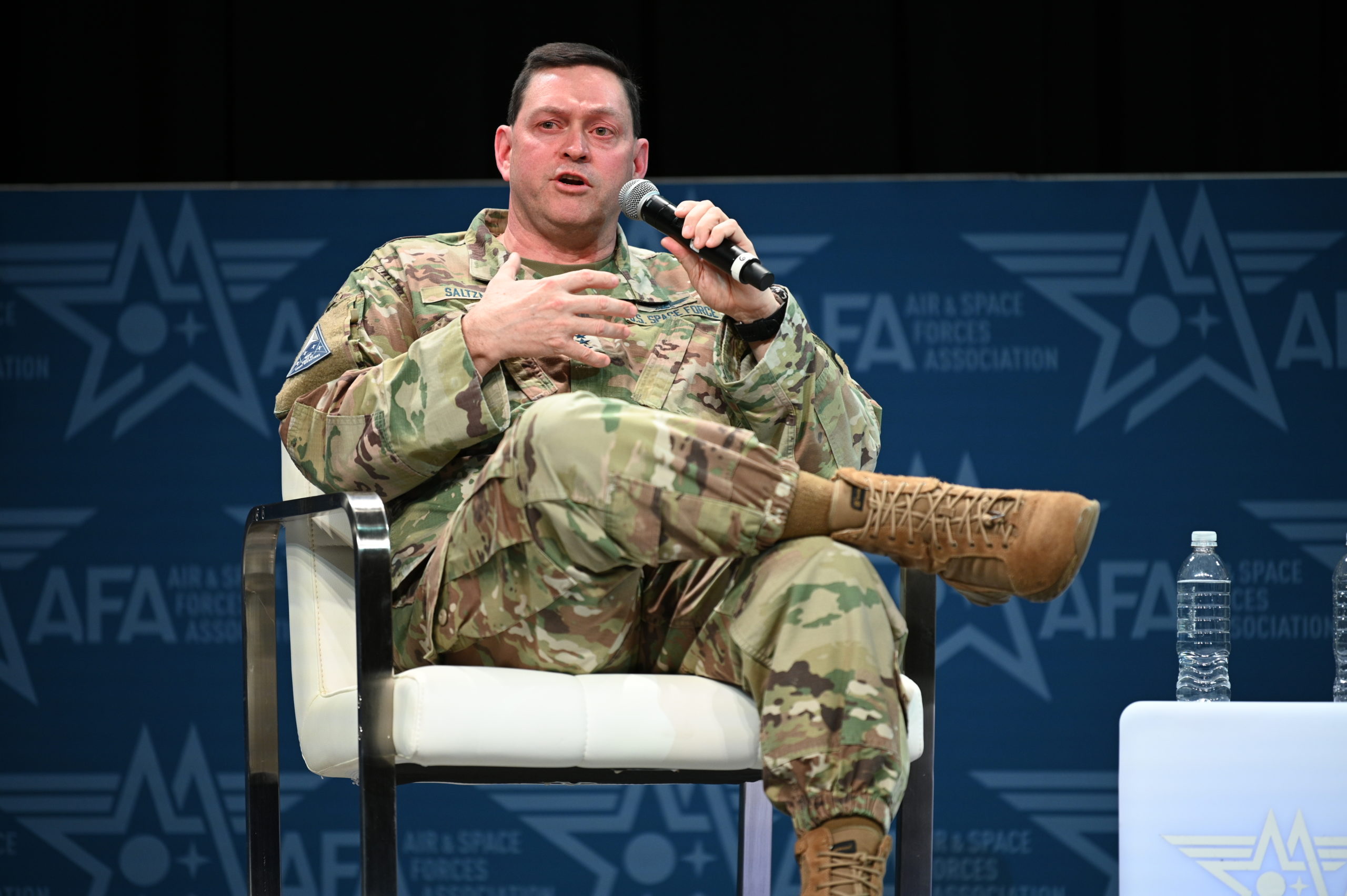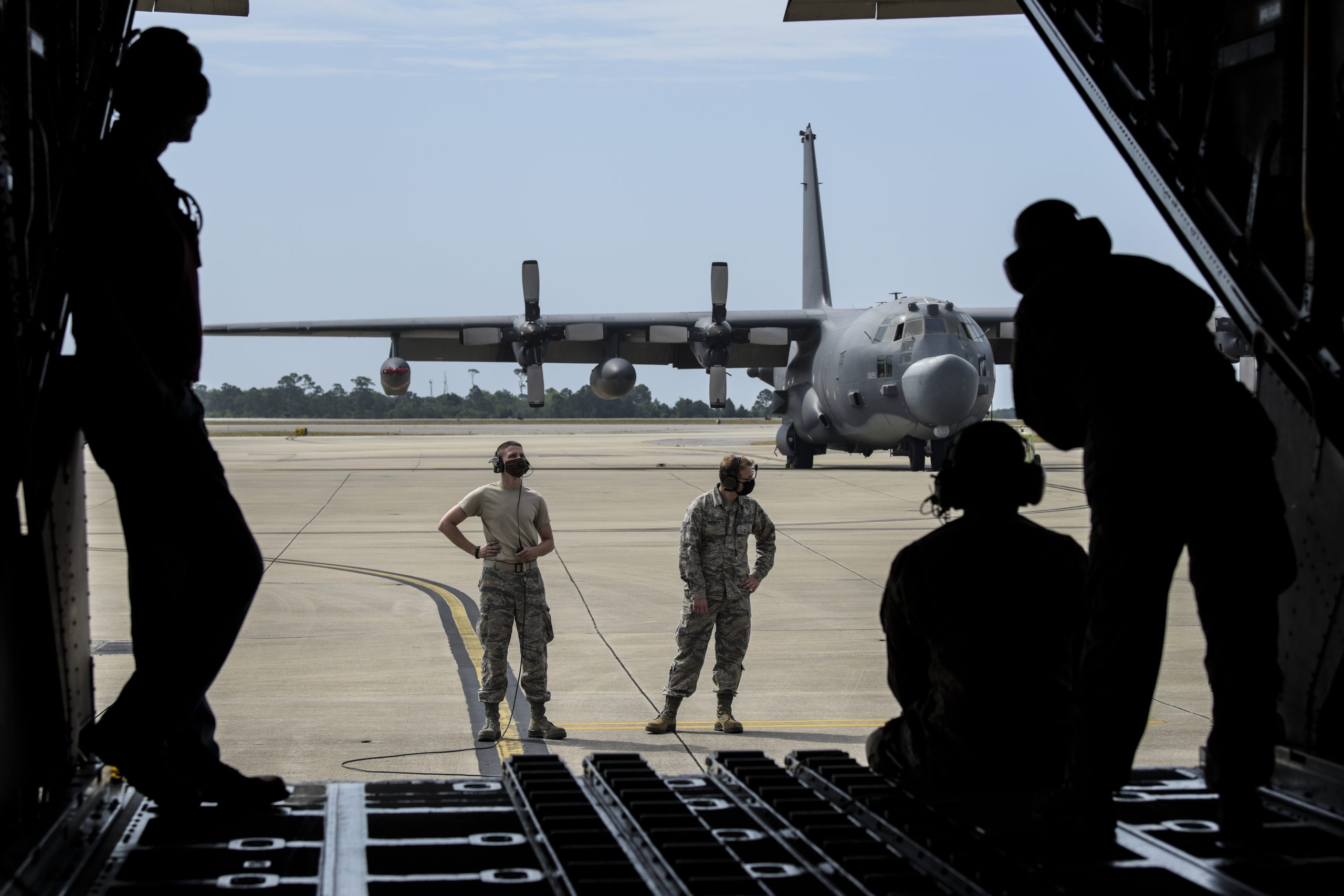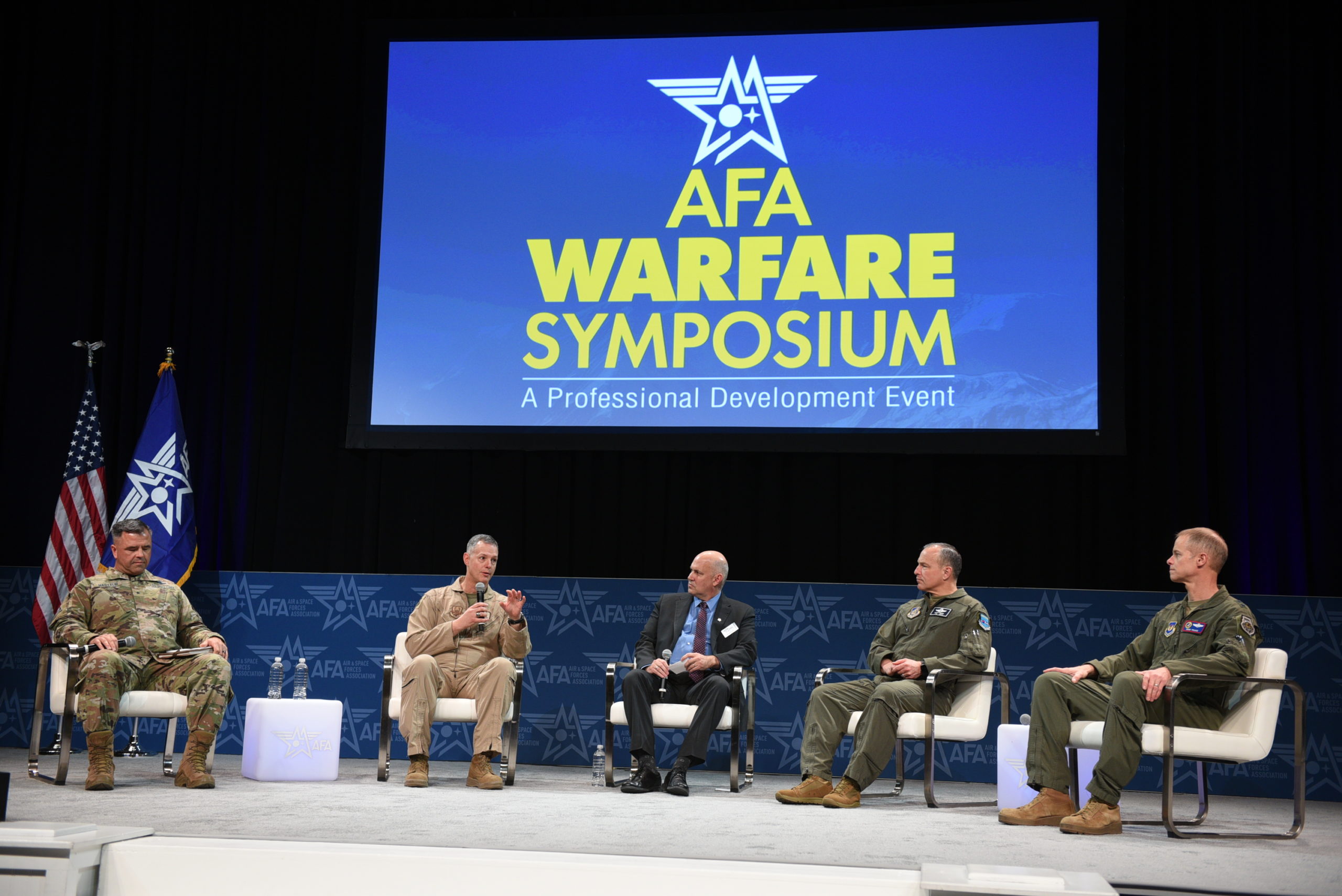Brig. Gen. Jeffery Valenzia, DAF Advance Battle Management System Cross Functional Team lead; Col. Frederick “Trey” Coleman, commander of the 505th Command and Control Wing; retired Lt. Gen. Dave Deptula, dean of the Mitchell Institute for Aerospace Studies; and Heather Penney, senior resident fellow at the Mitchell Institute for Aerospace Studies sat down to discuss ways to accelerate the Pentagon and the Air Force’s transition to a better command-and-control architecture in a panel on ‘Optimizing C2 to Assure Kill Web Dominance,’ on March 7, 2023 at the AFA Warfare Symposium. Watch the video or read the transcript below.
Heather Penney:
Good afternoon everyone. I’m Heather Penney, Senior Resident Fellow at the Mitchell Institute for Aerospace Studies and welcome to our panel on optimizing C2 and kill web dominance. As you know, China has been studying how we as a nation conduct combat operations and as a consequence, they’ve developed a war fighting strategy of systems destruction, which seeks to dismantle how we go to war by blinding and destroying our ISR capabilities, isolating our command and control and taking our data links. This is clearly problematic in a highly contested environment where we will have to close thousands of kill chains against dynamic and fleeting targets with limited resources. Command and control, battle management will be key to achieving kill web dominance. So we’re pleased to host Brigadier General Jeffrey “Spaniard” Valenzia, Colonel Trey Coleman and Lieutenant General David Deptula to discuss this important topic.
General Valenzia is a secretary’s operational lead for operationally focused ABMS. His team guides threatened formed and concept driven command and control modernization, linking war fighting capabilities to decision to advantage in competition, crisis and conflict. Colonel Trey Coleman is an air battle manager that currently serves as a commander of the 505th command and control wing at Hurlburt Field. The 505th is responsible for testing, training, and developing the tactics, techniques and procedures for C2 systems that range from JTACS to JWACS. Trey’s also commanded the 609th Air Operations Center in Al Udeid and the 961st AACS squadron at Kadena. And finally we have our very own Dean of the Mitchell Institute, Lieutenant General David Deptula, who’s participated in actual command and control of joint forces in multiple real world joint operations like Desert Storm, Northern Watch, Enduring Freedom and Unified Assistance, and is a foremost expert on the topic.
Again gentlemen, thank you for joining us today. I’d like to kick things off today by giving each of you a few minutes to share some of your thoughts and General Deptula we’ll start with you.
Lt. Gen. Dave Deptula (Ret.):
Well, thanks very much Heather. What I’d like to do to kick this off is to highlight kind of what’s going on in this subject area at this strategic level to emphasize just how important the job is of General Valenzia, Colonel Coleman and all the others who are working to get us to the next level of command and control and why that’s so vitally important. The US and our allies were at a critical point in history, at the center of an information in war revolution, if you will. And what I’m talking about is this revolution sort of where the speed of information and the advance of technology as well as organizational design are merging to change the way that we execute military operations. In the third decade of the 21st century, what it demands is a new, more agile and integrated operational framework for the employment of allied military power and to shift away from the structure of segregated air, sea, land and space employment. That basically has been our history.
So while the competencies of how to operate in each of those separate domains is still going to be required, we can achieve dramatic synergy of those operating forces if we can command and control them as an integrated whole. That’s an imperative if we’re going to win the next major regional conflict. And it’s an imperative because we’ll be relying on our information advantage to compensate for our capacity disadvantages. Remember, we’re currently the oldest and the smallest Air Force we’ve ever been in our entire history and we’re on a path to only get smaller and older by 2027, which is the same year, some anticipate China will be able to take Taiwan by force. So we’ve got to move toward the advantage that all domain synergy can achieve, embracing complimentary vice merely additive employment of individual domain capabilities. Desired military effects increasingly will be generated by the interaction of systems that share information and empower one another.
And what’s important to realize is this phenomena isn’t restricted to an individual technology nor is it isolated to a specific service, domain or task. That’s what I’d tell you or suggest is the vision of joint all domain command and control. Working in an environment that’s an operating paradigm where information, data management, connectivity and command and control are core mission priorities. It envisions every platform as a sensor as well as an effector and requires the JADC2 enable linking, automatically seamless data transfer, all the while being reliable, secure and jam proof. Now that doesn’t mean that every system needs to be connected all the time, but to where and what is required when it’s required. To a degree the JADC2 concept inverts the paradigm of combined arms warfare making information the focal point, not necessarily the weapon systems themselves. So with that, over to you Spaniard.
Brig. Gen. Jeffery Valenzia:
Thanks sir. My name’s Jeff Valenzia, introduced part of the ABMS cross-functional team. I’m actually really only one of four who are carrying in this mantle on behalf of OI2 and what we heard the secretary talk about earlier today. So I represent the air operational community as we look at command and control. My counterparts, Major General John Olson who looks at the space. And then a really important partnership we have is with C3BM, PEO, the Brigadier General Luke Cropsey, and Dr. Brian Tipton. It’s important to understand that when we talk about command and control, we’re really talking about the totality from the operational side to the derived technical side to how we’re going to deliver. A lot of what General Deptula just laid out for you.
I’m just going to lay down two things just to understand where we sit from an operational community. Number one, what is and is not command and control. Command and control is planning. It’s what our commanders do, how they make the decisions that they make, how they allocate resources, delegate authorities, establish priorities, and then it’s the controlling apparatus that executes in a very dynamic and challenging operational environment that’s constantly changing in order to keep that fixed commander’s intent as the outcome for that day’s activities. It’s not connectivity. We depend a lot on connectivity and it’s an important derived technical requirement that General Cropsey and Brian Tipton work very hard to deliver for us. It’s not data access, but we do care a lot about the data we have. But frankly, the data managers that we have today, they’ll operate off of a radio call. They’ll operate off of the most arbitrary source of data in order to derive the best tactical outcome. We know we can get them more, we care deeply about it, but our battle managers are going to succeed with whatever data we give them.
It’s not about intelligence and how we do the exploitation of targets to identify the priorities for the day or to help us with developing the targeting solution. It’s not about sensing, but we care deeply about our sensors and the information that they have out there. Ultimately when you start looking at what command and control is and is not, it establishes some really cool boundaries that help us to focus our effort in specified ways.
The second that I’ll leave you with is our C2 system that we have today is simply inadequate against the adversary that we’ve been told is our pacing threat. And we need a new C2 system today, not five years from now, not 10 years from now. So to do that, we got to focus on the tools in the TTPs while we allow the technologist to look at advancing technologies that can help us to improve better. But if we start waiting for the technology before we get after the tools and TTPs, we’re already too late. Thanks.
Col. Frederick “Trey” Coleman:
Okay, thanks for having me. I’m Trey Coleman and I’m an air battle manager. And there’s never been a better time to be in this business, to be in the C2 business at large. So I’m really excited about this. It’s amazing that nearly the entire focus of this event is on C2 and never before have we had conferences focused so exclusively on this core function that General Brown laid out for us as he laid it out this morning. I’ve got this theory about C2 and it goes something like this. There’s an inverse relationship between the size of your force and your need for C2. And if you draw back, if you think back to World War II when we had about 300,000 airplanes in the inventory, what did our C2 apparatus look like? There wasn’t much there, right? We had some really nascent radio, some really nascent radar capability, but there wasn’t much C2. And then we’d send a bomber force out and maybe half would come back sometimes and that’s how we did business. But you had 300,000 airplanes.
Fast-forward to Vietnam when you had 17,000 airplanes, 7,000 of which were fighters. And we had what I would call our first generation C2 force, some basic ground control capability. You had the EC-121 figuring out how to do this C2 thing. And then in the 80s and 90s we started delivering the AWACS and the J Stars and the AOC and that was our second generation C2 force and that’s what we still have today. And so we have this second generation C2 force and we’re facing a sixth generation fight. And so it is time now to not just… The name of this panel is optimizing C2. I think we got to revolutionize it. We got to jump about four generations if we want to keep up with the pacing challenges General Valenzia just mentioned. So I’m looking forward to this panel and to continue to work with the likes of General Valenzia and General Cropsey and the enterprise here to make this right.
Heather Penney:
Thank you so much. And if you haven’t had a chance, Colonel Coleman has written a series on command and control that you can find in the Mitchell Institute website and they’re excellent. They’re quick reads but they’re very rich reads. So to begin off with the questions, I’d like to kind of go back in time. General Deptula, you started talking about building a combat cloud a decade or so ago and that term is morphed into the acronym now, JADC2. Could you please give us an assessment of why it’s taking so long to actualize and what are the key actions that need to occur to get this accomplished?
Lt. Gen. Dave Deptula (Ret.):
Well thanks Heather. And since this panel was put together in the planning stages, there’s some good news with respect to how I might answer that question. And that’s basically the Secretary of Defense mentioned this topic in his letter to the force this past Thursday that I’m sure many of you have seen. And what he said was he’s really interested in it. And I quote, “Accelerating joint all domain command and control is a priority.” So that was the first thing I was going to tell you is JADC2 has got to have a champion and the best champion it could have is the Secretary of Defense. Otherwise, it wouldn’t be getting the necessary attention by all of his services to accelerate it. Because even with the great work that the JADC2 cross-functional teams are doing, pushing up the initial operational capability for it won’t happen without the Secretary of Defense making it one of his priorities. And now he has.
Okay, that said, the goal of actualizing JADC2 still faces a lot of challenges. One of those, as Spaniard mentioned, it isn’t JADC2, but what’s important is assuring connectivity. And that’s also been recognized as the JADC2 cross-functional teams have recently set up the transport and war fighter communications working group. So while there’s a heck of a lot to be done, the bottom line is I think that the Department of Defense has got the… He has the message now that it’s got to move out faster in making JADC2 a reality. And we all heard the secretary of the Air Force mention it today. So I think there’s plenty of awareness, there’s a lot of activity moving it forward.
Heather Penney:
Thank you. General Valenzia, I really appreciated your comments at the beginning of the panel regarding what JADC2 is and is not. And so to follow up on that, it seems that there’s a lot that we can do from a tactical, operational, doctrinal and even organizational perspective to get at these problems. And we’ve all talked about how we can do things differently with what we have right now that would make a significant difference. So I’d like to start with you, what one change do you think would make one of the biggest differences in being able to accelerate command and control in ABMS?
Brig. Gen. Jeffery Valenzia:
Can I give you two?
Heather Penney:
Absolutely.
Brig. Gen. Jeffery Valenzia:
I got the mic, right?
Heather Penney:
Absolutely. You got the mic.
Brig. Gen. Jeffery Valenzia:
Okay, so I’m going to go back to my opening comments. What I was trying to characterize is what is and is not C2. JADC2 is a lot of things. So my first thing is I would get a Men in Black pen and I’d put in front of all you and I’d click it so you guys get over your hangover of what you think it is or should be and actually look at where we’re going with it today. The second thing that I would do is for the operators out here in the community, you got to get together. You guys are screaming at our acquisition community and the technical integrators with too many voices. And when I look at Luke Cropsey and Brian Tipton, what they’re trying to do to ratify and make some really tough technical choices, what they’re finding behind them is so many shouting voices from the operational community that they’re having a very difficult time making those decisions.
And so what I would do is let’s get over what we think it could have been, should have been, and then start looking at what it is. I bounded it one way for you. That is one way of bounding it. And that would just offer that if we get together as an operational community of which… That’s part of what the CFT represents, then I think we can get to the acceleration, which was the core of your question to General Deptula is why is it taking so damn long? And I think if we did those two things, we probably could see some really impressive progress in a much shorter period of time.
Col. Frederick “Trey” Coleman:
Can I have three? I just want to do more than him if that’s okay. So the first two are pretty quick. And the first one is we got to incentivize folks to move to the cloud. Everybody’s got their own data centers and their data storage capabilities and we got to get folks in the cloud because you’re can’t be agile until you’re in the cloud. The second is, this is a self-promotion for the 505th command control wing is we have a great battle lab at Nellis Air Force base called the Shock. We need your systems. If you got a cool system, whether you’re industry or you’re an air component or you’re a wing, bring us your systems, plug it in at our facility. We have a great facility with our own ATO, three year ATO.
We can say yes in days and plug it in and see how it works in the Nellis range and then we can integrate them. We still have lots of great systems out there. As a matter of fact, I think we have all the systems we need, but we’re not integrating them in the battle of Nellis is the place to do it. So the second is, bring me your systems. The third is bigger and I think this is how you actually have lasting change is if C2 is a core function, it’s one of the five things we do. Global mobility, global strike or superiority, ISR, C2, those are the five things. When you look at global mobility, they’ve got air mobility command championing them. When you look at global strike, they got global strike command championing them. Well who’s the champion for C2? How do we organize C2?
We don’t. We don’t have a NAF, we don’t have a four star headquarters because everybody does C2 and it’s kind of part and parcel to all of our missions. But I’d argue that’s how we got ourselves into the position where we have a second generation C2 force and a sixth generation fight is because we don’t organize that. We don’t organize for it, we don’t have a champion for it. And so if I could make a wish and grant it, it would be that we had some kind of NAF structure with a three or four star general for C2 that organized and trained, equipped C2 forces the way that we do for the mobility core function or for the global strike core function.
Lt. Gen. Dave Deptula (Ret.):
You want…
Heather Penney:
Go ahead.
Lt. Gen. Dave Deptula (Ret.):
You want one or two or three or how many?
Col. Frederick “Trey” Coleman:
You got to do four, sir.
Lt. Gen. Dave Deptula (Ret.):
I was going to go back to one. And quite frankly it’s the last one that you talked about and it’s sort of combined to what I was trying to say with respect to having a champion. Organizationally, we are still unfortunately as a military organized in a pre-industrial Napoleonic construct with an AJG 1, 2, 3, 4, 5, 6, 7, 8, 9, 10, which doesn’t really work very well in terms of finding someone who’s the champion for command and control. That’s why I was saying, look, you want to get attention, you want to get this thing moving. You get the Secretary of Defense who asks at every frapping meeting, how are we doing service chiefs? When’s IOC going to occur? Now it also helped to have a well-defined and common architecture that everyone understands. So that’s another part of the puzzle.
Heather Penney:
Well, I think it’s interesting that in many ways as we talk about this, the connectivity piece, which is not command and control, it’s not battle management. The assured elements of that, again, we’re devolving back to… And there are important pieces of the technical aspects that enable us, but we need to get back to the operational focus. General Valenzia, would you like to speak a little bit to that of how you, as you’re approaching ABMS, you’re looking at the operational elements of it and not necessarily just the technical pieces and how you’re beginning to integrate some fidelity in measuring what matters?
Brig. Gen. Jeffery Valenzia:
It begins with you need to contextualize the fight we’re trying to fight the same way. It’s getting away from just producing OV-1’s or imaginations on where you think we could go within a fight. And let’s look at where we really are within the fight. For us, we’re paced off of INDOPACOM. We’re not pacing ourselves off of a future plan. We’re looking at the current plan. We’re breaking it down to joint mission threads that we can then decompose into how each of the components contribute to the overall outcome. And from that, using a very disciplined approach, we can start to identify operational focus areas. This is how we’re going to start to galvanize number one, bringing the operational voice into coherency for the acquisition and technical communities. This is how we’re going to bring industry to become a partner in the development rather than just in a sidecar hoping to keep up with us.
This is where we’re going to drive the clarity so that we can show return on investment when we walk into the boardroom within the Air Force and we say, this is where we want you to invest your money. We can show the ROI, we can show how it’s inclusive of our partners, we can show how it’s scalability to a larger conflict. If we don’t do those things right, and this is the operational community’s imperative. If we don’t do those things right, I don’t think we can expect that we’re going to get some magic technology that’s going to turn this over for us.
Heather Penney:
Thank you. And I don’t mean to belittle how important that kind of connectivity and connecting all the different pieces in the battle space are, but I do think it’s important that we make… There’s a differentiation between how we employ them, how we operationalize them, and how we control them. Which leads me to my next question, Colonel Coleman, as I mentioned, you’ve done a number, series of papers on command and control and one of them was on distributed control. Can you speak to that because I think that that’s a really important piece of how we begin to continue to operationalize battle management in a highly contested environment where we may not necessarily have connectivity all the way back to the mothership?
Col. Frederick “Trey” Coleman:
Thanks Penney. That’s a great question. So we have this second generation C2 force that we’re fighting with today is built to be centralized. Our air operation centers, our air components are built to be centralized. And even at the tactical level, if you look at what we did with Kingpin out in Absent, where you had multiple CRCs that we created one large CRC called Kingpin that takes care of the whole theater. We’ve centralized our C2 and that’s a very efficient thing to do, but it will not work in a fight against China because they can shut it off kinetically or not kinetically and shut it down. That one facility, it’s a single point of failure, game over. And so we got to figure out how to get through that.
There’s two ways to do it. One is mission command where you empower the tactical level. And I think there’s a lot of goodness in that, particularly through those [inaudible 00:21:00] four channels with the AW commanders, move your jets where you need to move them, launch the jets for when you need to launch them to defend your airspace. But there is still a need for that operational C2 layer. In fact, going back to my opening comments, there’s more of a need now with our smaller force than there’s ever been to get the right aircraft or the right asset in the right place at the right time. We don’t have enough to lose. We don’t have enough to… We can’t afford to have half the force come back. So we got to get it in the right place in the right time. And that’s what the AOC does and that’s what the air component does. But if it’s not survivable in its single vulnerable position, the solution is distribution.
So when we changed doctrine, when the Air Force changed doctrine, it used to be, remember, centralized control, decentralized execution. When we differentiated command from control, which was a much needed change and really is a revolutionary way of thinking about it. Now you have to have a centralized commander, right? Centralized command, one person is making that decision, but your control can be distributed. And so instead of having a single facility, you have four or five, six facilities or you disperse it to maybe some [inaudible 00:22:00] agencies or the walks or other folks are crowdsourcing those operational C2 functions that you still need.
You still need a strategy. You still need to prioritize targets. You still need to match assets to targets. You still have to have whatever you call it. I think ATO called it a sync matrix, call it a flight schedule. Somebody’s got to figure out when the airplanes are going to be in the right position at the right time so they can be packaged appropriately and go downtown. Somebody’s got to do that job. And if you can’t have it in the same facility and you can’t push it down to a lower appropriate level, then the solution is distribution. To do that effectively, you have to have cloud capabilities, you have to have secure transport, you have to have a degree of automation. And those tools and those systems exist today. We just need to harness them and get comfortable with them.
Heather Penney:
Thank you. And thank you for making the connection between how we actually operate and the technologies that we’ll need to facilitate to make all of that happen. But I’d like to get back to the people part. And Colonel Coleman, so this gets back to the air battle managers. I mean, as an Air Force, our people are tied to platforms. So as we begin to divest J Stars, as we begin divest our E3 AWACS, that’s going to have significant impact on the air battle managers that have been tied to those platforms. So how do we retain the intellectual capital? How do we continue to keep that core expertise as we transition towards the future advanced battle managers?
Col. Frederick “Trey” Coleman:
That’s a great question. And it’s a really exciting one because I think the air battle management career field is really only 20 years old or so. As a matter of fact, when I came in as a lieutenant, we weren’t rated and then we became rated. And I remember being a lieutenant and your greatest hopes were maybe you can make lieutenant colonel. And we had our first squadron commander like in 2001, and it’s taken off since then. But times are changing. And in the day we focused exclusively on tactical C2 ,on making threat calls. Threat six are making picture calls, two groups ESMA 10. And I think those days are getting behind us. I don’t think the F-35 and the F-22 and the NGAD need that kind of tactical control the way that they did, the way that we grew up with F-16s and F-15s and in making those kinds of calls.
But I think that the need for no kidding battle management at the upper tactical and the lower operational where you’re doing dynamic force packaging, where you’re calling alert cells, where you’re doing cap management, those needs still exist and they’re probably greater than ever before. And I’d argue that this career field is the only career field in the Air Force that starts from day one with C2. I mean everybody does C2, a wing commander does see two, a flight commander, the security forces squadron does C2 when he says… Tells the gate, close this gate, open that open gate, CFAXs do C2, everybody does C2, but ABMS are the only one that do it from day from one. They enter the service and they spend a year in undergraduate training learning about how to do C2 and they do it for their entire career field.
And so what I’d like to see, what I would personally like to see the ABM career field morph into as we transition out of AWACS into E-7, as we transition away from J Stars into the talk family of systems, I’d like us to also incorporate more of that operational C2 function. I think that you should see your air battle managers more as C2 experts from both the tactical and the operational level. So they start in a tactical platform and they get into the air components and they’re working in the AOCs and they’re C2 experts their entire career, instead of just focusing on exclusively on the tactical C2. That’s where I would like to see us go.
Heather Penney:
Thank you. So the title of this panel is command and control and optimizing kill chain dominance. So let’s kind of walk backwards a little bit and define terms of reference. Gentlemen, how would you define kill chain dominance? Gen. Deptula, we haven’t heard from you for a bit.
Lt. Gen. Dave Deptula (Ret.):
Yeah, I see my partner’s over here looking at each other. So I’ll give you a break. I’m going to give you a chance to think about it while… I define the kill web as a collection of sensors netted with command and control, that are able to pass critical information to the right weapon systems to achieve the right effects or desired effects. And to be dominant means that these means of connection have to be multi-path. They got to be multi-directional and they’ve got to be resilient. We have to be careful here too, because Trey mentioned something earlier in one of his answers, or maybe it was Spaniard, forgive me if I attribute wrong, but we also have to be careful that we don’t get to the point where we rely on connectivity because oftentimes we talk about assured connectivity, but guess what? The enemy gets a vote.
And we’re not always going to be assured connectivity. So we also have to build a capability into our personnel to be able to operate with an understanding, which goes back to the mission command piece to operate autonomously. But dominant means building a network such that even if an adversary does attack it, it doesn’t completely go down. Sure, it’s going to be degraded. We have to plan for the time it goes away. I think if we do this right, we can maintain a semblance of capability and at least if we train our folks right and battle managers, if connectivity does go out, we still continue to operate and we get it regained. Well, obviously we can get better at it, but sorry, it’s a little bit long, but the fact of the matter is web dominance means being able to operate even when you might not be able to communicate with one another.
Heather Penney:
General Valenzia, I know that you and I have a lot of conversations about this. You’ve got a somewhat contrarian view, so would you mind kind of sharing that with us?
Brig. Gen. Jeffery Valenzia:
Aren’t we close to the end of our time?
Heather Penney:
Don’t worry, we’re getting into the lightning round next.
Brig. Gen. Jeffery Valenzia:
I don’t know what a kill web is. I just don’t. Trying to operate off a very precise language so that we can do the hard work to deliver war fighting, war winning capability. I’ve lost the granularity on what a kill web is. I’ve actually lost the granularity on what a kill chain is because it’s become an imprecise term we’ve somewhat walked away from it. And because I don’t know how to measure it, I don’t know how to evaluate it, I can’t see consistency across the many conversations I have. We’ve just walked away from it. So to me, it’s a term of convenience, but it’s not more of a term of art than a term of science that we’re going to measure improvements to war fighting.
Heather Penney:
And I think that’s fine. Having terms of convenience that can become sort of a common shorthand for most of us can be useful. But I think that what you’re really getting at is the distinction between how we use it colloquially and then actually what you are doing within your ABMS studies in terms of really getting into the functional decomposition so that you can measure what’s actually going on within the broader system of systems. So from an engineering standpoint, it doesn’t provide you, as you mentioned, the granularity, the fidelity that you need for what you’re actually studying to determine where you get advantage and where you don’t. But I don’t know from my perspective, that kill chain or kill web loses value from the broader perspective of how we look at it. Although from an engineering standpoint, I can understand why that’s not quite as useful. Gentlemen, do you have anything else to add before we move into the lightning round?
Okay. All right. Well, General Deptula, we’ll leave you with the last word. So in order of rank then, Colonel Coleman lightning round with you, then General Valenzia and then to General Deptula.
Col. Frederick “Trey” Coleman:
Well, I won’t take a lot of time here, so I’m excited about where we’re going. There’s never been a better time to be in this business. Thanks for your passion for it and bring me your systems to the Shock. Thanks.
Brig. Gen. Jeffery Valenzia:
Yeah, I’ll just say thanks to AFA for creating these venues, driving these conversations. As Trey hit earlier, and just thanks to my fellow panelists and of course, Lucky for moderating this.
Lt. Gen. Dave Deptula (Ret.):
I’d like everyone to take away the understanding that design, development and actualization of JADC2 is an absolute imperative if we’re going to win in the next major regional conflict.
Heather Penney:
Amen. So with that, ladies and gentlemen, we’ve come to the end of our discussion. This was a very short panel today. We only had 30 minutes vice the normal 40. I’d once again to thank all of our panelists for their time and their insights, and from all of us at the Air Force Association and the Mitchell Institute, have a great aerospace power kind of day. Thank you.
Col. Frederick “Trey” Coleman:
Yeah, I love that ending.
